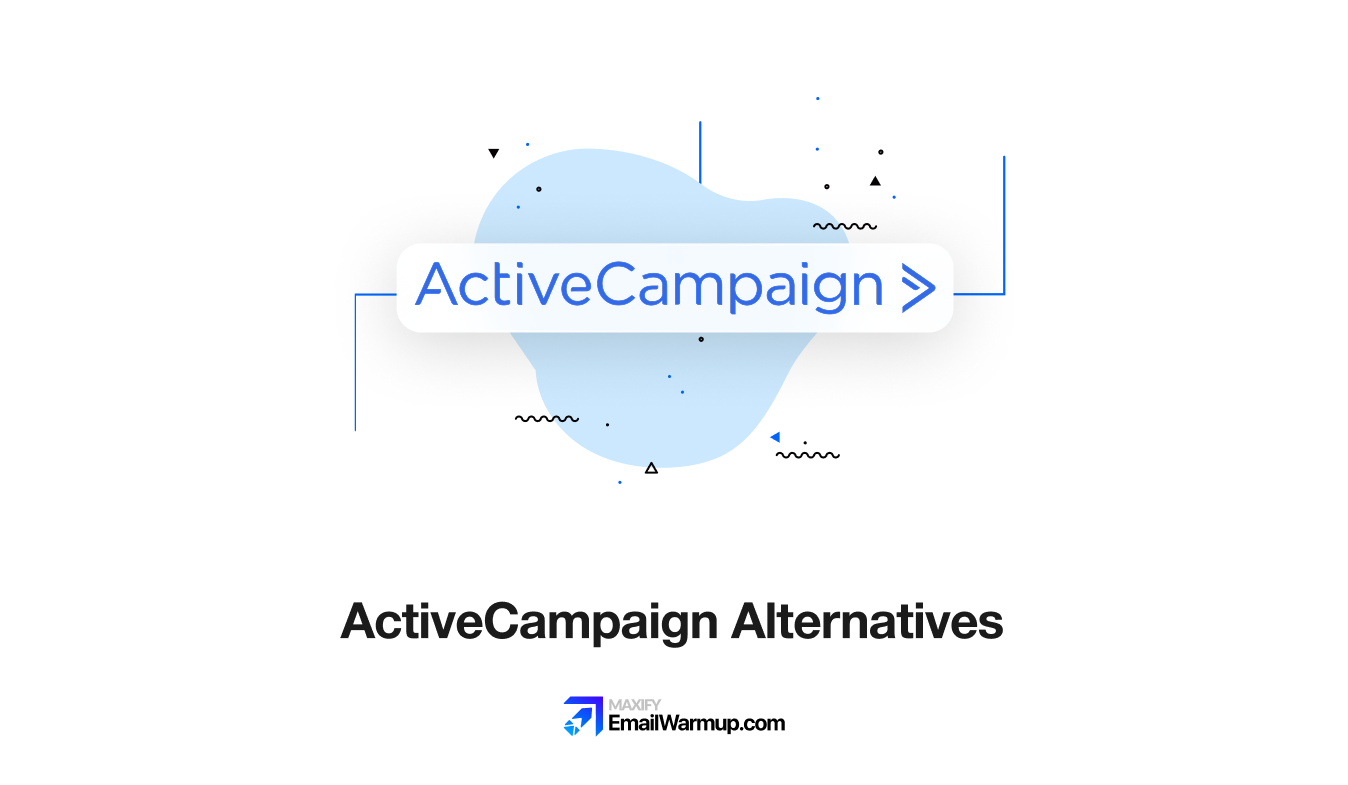
ActiveCampaign delivers powerful automation, but its steep learning curve, escalating costs, and basic CRM features push businesses toward better-fit alternatives.
As an email marketing consultant who has helped hundreds of businesses rebuild email revenue streams (including several migrations away from ActiveCampaign), I’ve prepped this guide covering:
- Creator-focused tools with native monetization
- Budget-friendly options that won’t punish list growth
- Specialized solutions for agencies, events, and Gmail users
- All-in-one CRM platforms prioritize sales teams
- E-commerce specialists built for online stores
Whether you’re drowning in complexity or watching your monthly bill skyrocket as your list grows, there’s an ActiveCampaign alternative built specifically for your situation.
TLDR: ActiveCampaign alternatives (Quick overview)
Here is a quick skim of our list of 17 top ActiveCampaign alternatives:
| Platform | Best for | Starting price | Standout feature |
| HubSpot | Enterprise CRM | $20/mo | Free CRM with up to 1M contacts |
| Keap | Small business all-in-one | $169/mo | Native payment processing |
| EngageBay | Budget startups | Free | All-in-one suite at a fraction of the cost |
| Close | Sales teams | $29/user/mo | Built by salespeople for sales |
| Klaviyo | E-commerce | $20/mo | Predictive purchase analytics |
| Drip | DTC brands | $39/mo | Revenue-focused automation |
| Omnisend | Online retailers | $16/mo | Omnichannel workflows |
| FunnelKit | WooCommerce | $249.50/yr | Unlimited contacts, fixed price |
| Kit (ConvertKit) | Content creators | Free | Built-in product selling |
| Beehiiv | Newsletter publishers | Free | Cross-promotion network |
| Flodesk | Design-focused creators | $35/mo | Flat rate, unlimited subscribers |
| Brevo | Budget users | Free | Pay per email, not contacts |
| MailerLite | Beginners | Free | Simplest automation builder |
| Mailchimp | Small businesses | Free | 5,000+ integrations |
| GMass | Gmail users | Varies | Works inside Gmail |
| Constant Contact | Event organizers | $12/mo | Native event management |
| HighLevel | Agencies | $297/mo | White-label reselling |
1. HubSpot
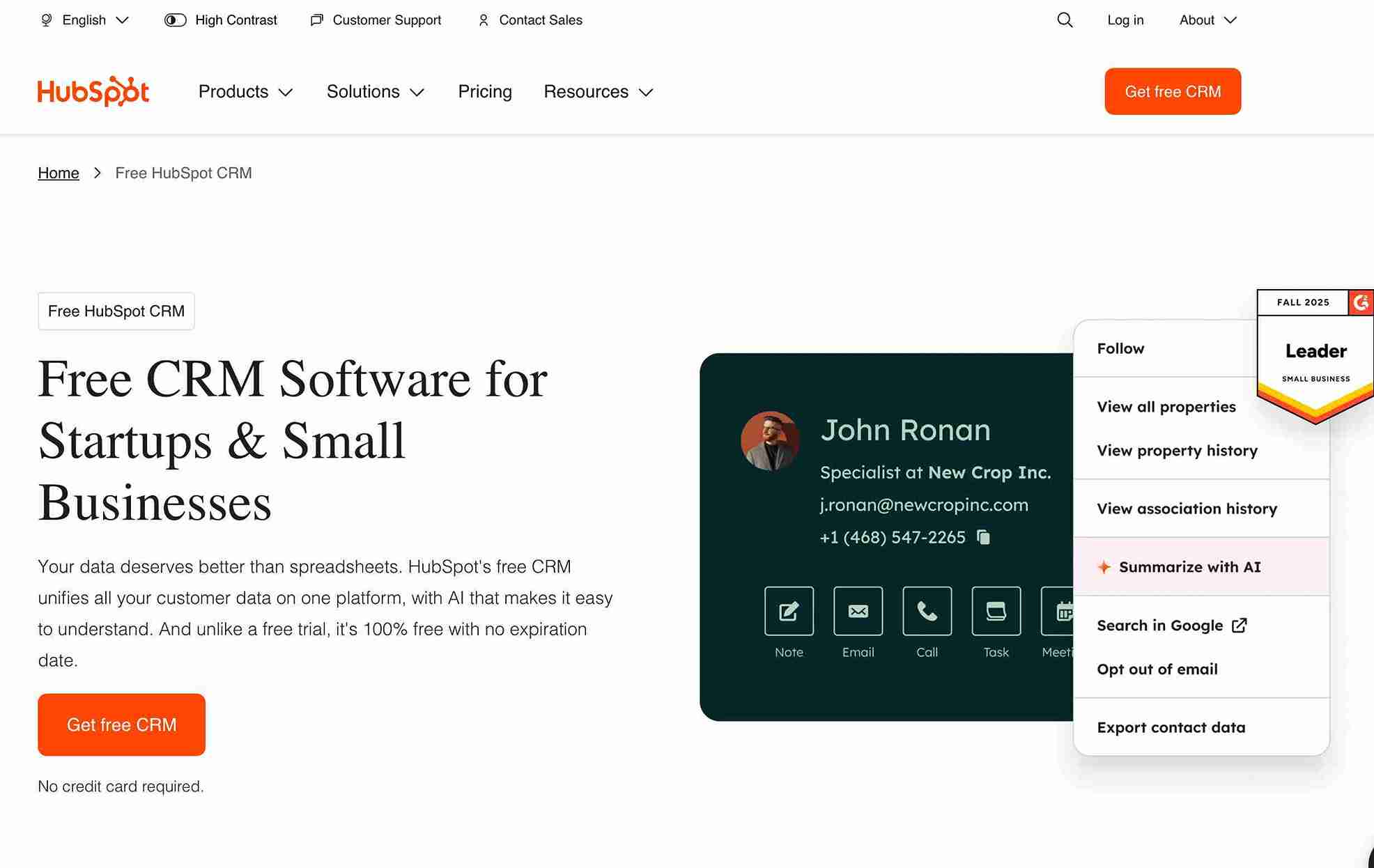
HubSpot builds everything around its CRM rather than email marketing (unlike ActiveCampaign, which adds CRM as an afterthought). The platform is divided into separate Hubs covering Marketing, Sales, Service, CMS, Operations, and Commerce. My agency partner switched specifically because their sales team needed robust pipeline management that ActiveCampaign’s basic CRM couldn’t deliver. You start small and expand as needs grow.
Key services or features offered by HubSpot
HubSpot delivers comprehensive tools across departments:
- Over 1,000 third-party integrations
- Free CRM supporting unlimited users and up to 1 million contacts
- Sales Hub with meeting scheduling, pipeline tracking, and lead scoring
- Marketing Hub with email marketing, landing pages, and lead nurturing
- AI-powered features for personalized outreach and data enrichment
- Custom reporting with source data analysis
HubSpot pricing
Marketing Hub Starter starts at $20/month, jumps to $800-890/month (Professional), and reaches enterprise levels beyond that. Higher tiers include mandatory onboarding fees (sometimes several thousand dollars).
Pros and cons of HubSpot
Weighing HubSpot’s trade-offs:
| Pros | Cons |
| Robust CRM and sales features | Expensive for small businesses |
| Free CRM provides real value | Steep learning curve |
| Advanced custom reporting | Mandatory premium setup fees |
| Extensive integration ecosystem | May pay for unused features |
What users say about HubSpot
Users praise HubSpot’s CRM depth and reporting capabilities. Complaints center on cost and complexity (several clients told me they spent months before fully utilizing what they paid for).
2. Keap (Infusionsoft)
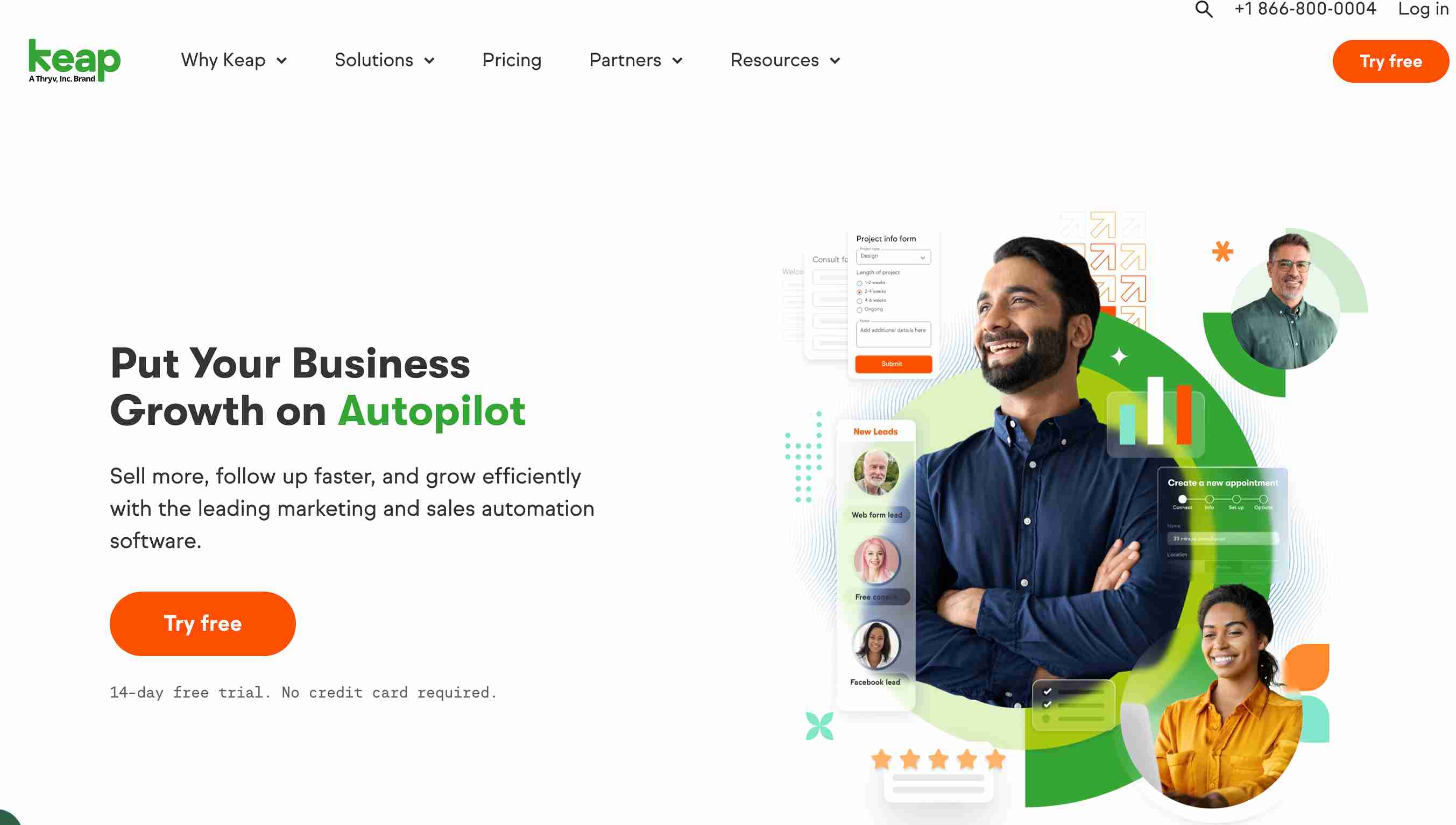
Keap bundles CRM, email marketing, invoicing, and payment processing into one package. Formerly Infusionsoft, Keap rebuilt its interface but maintained its focus on combining sales and marketing automation with financial tools. The platform works particularly well for service providers and e-commerce businesses who value having everything in one place (despite the higher entry price).
Key services or features offered by Keap
Keap bundles business essentials:
- Native payment processing and invoicing
- Built-in CRM with pipeline visualization and lead scoring
- Integration marketplace connecting hundreds of applications
- E-commerce tools with upsells, promo codes, and checkout cart
- Drag-and-drop email builder with automation workflows
- Appointment scheduling with a dedicated phone line
Keap pricing
The Pro plan costs around $169/month for 2 users, and the Max plan runs approximately $249/month for 3 users. The 14-day free trial helps test fit before committing.
Pros and cons of Keap
Balancing Keap’s all-in-one approach:
| Pros | Cons |
| True all-in-one with payment processing | Significantly more expensive |
| Strong e-commerce and invoicing | Steep learning curve |
| Comprehensive sales automation | Dashboard reporting lacks depth |
| Good value if you use everything | May require Zapier for complex tasks |
What users say about Keap
Users appreciate bundled payment processing but consistently mention high cost. Businesses either love Keap (using every feature) or regret overspending on unused capabilities.
3. EngageBay
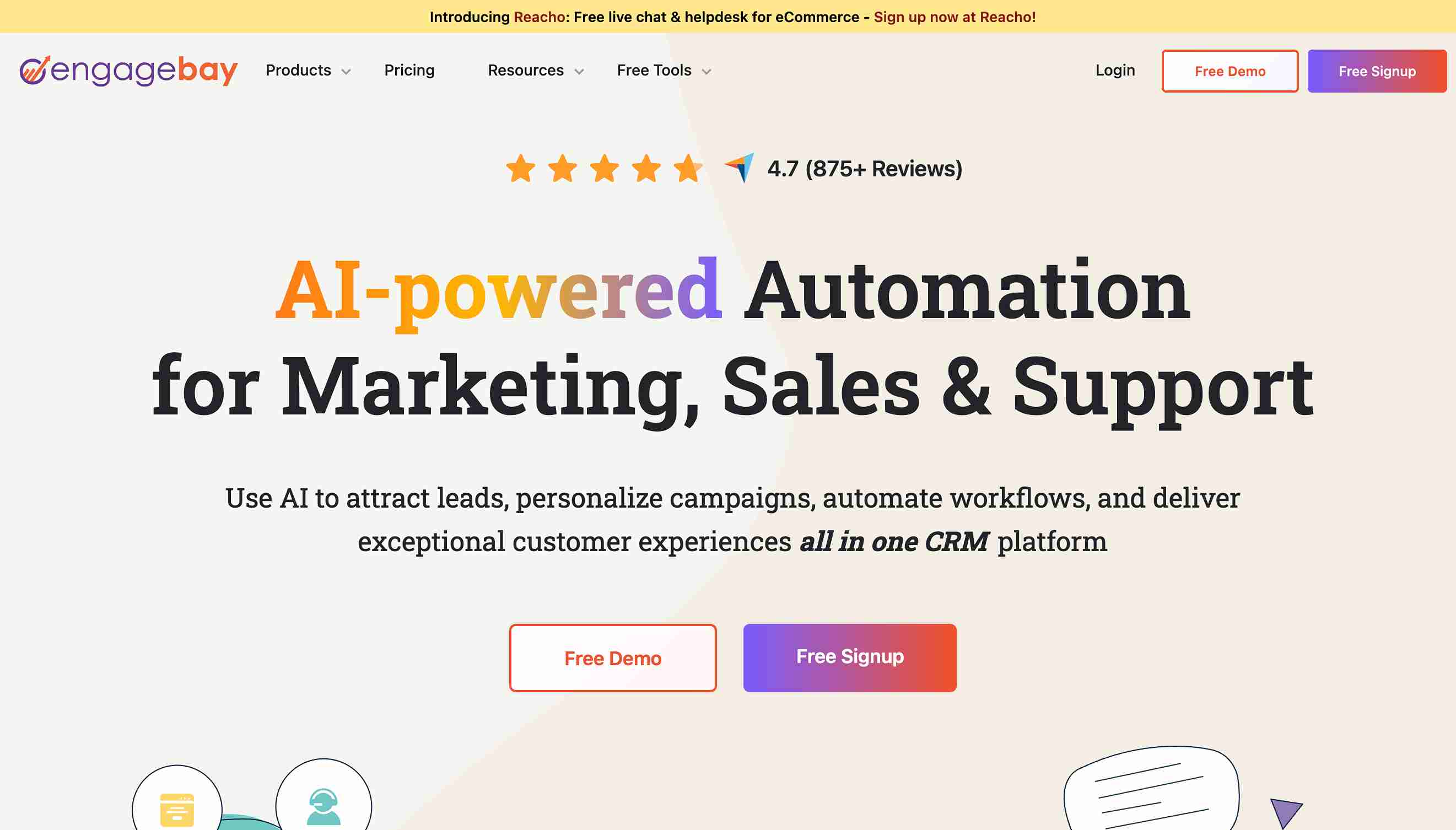
EngageBay offers HubSpot-like functionality at a fraction of the cost. Built for solopreneurs, startups, and small agencies, the platform bundles marketing, sales, and service tools with transparent, affordable pricing. You won’t find mandatory onboarding fees or complex tier structures here (refreshing compared to enterprise platforms).
Key services or features offered by EngageBay
EngageBay combines three bays:
- Visual sales pipeline tracking
- Service Bay with helpdesk, ticketing, and live chat
- Free CRM suite with deal management and 360-degree customer view
- Marketing Bay with email automation, landing pages, and multichannel outreach
- Multi-channel marketing across email, SMS, social, and push
- Predictive lead scoring and automated workflows
EngageBay pricing
Free forever plan includes CRM, helpdesk, live chat, email marketing, and landing pages for 250-500 contacts. Paid all-in-one plans start at $11.04-12.99/user/month. Pro plan supports up to 50,000 contacts at $110-120/month.
Pros and cons of EngageBay
Understanding EngageBay’s value:
| Pros | Cons |
| Extremely affordable | Limited third-party integrations |
| Free CRM on all plans | The interface can feel clunky |
| True all-in-one platform | No 24/7 support on premium plans |
| Excellent value for budget-conscious businesses | Lacks a dedicated mobile app |
What users say about EngageBay
Users consistently mention the value (HubSpot-like features at a fraction of the cost). Interface gets mixed reviews, but most agree that EngageBay delivers impressive functionality for the price.
4. Close
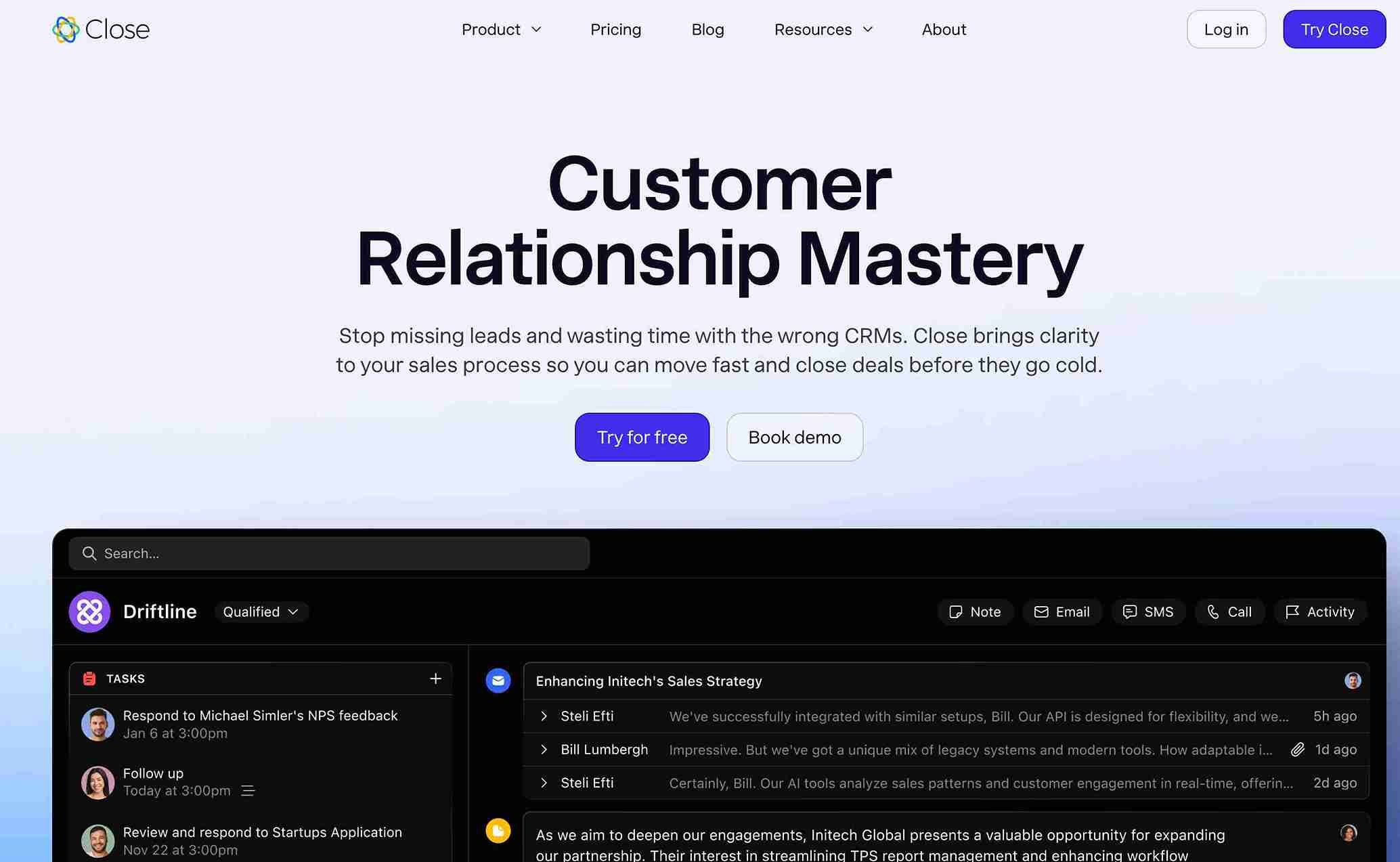
Close specializes exclusively in sales CRM, built by salespeople for sales teams. The platform handles call, email, and SMS communication from one interface. Your reps spend more time selling and less time updating spreadsheets (everything logs automatically).
Key services or features offered by Close
Close focuses on sales productivity:
- Smart Views prioritizes leads in real-time
- AI-powered call summarization and instant reports
- Automated follow-ups, task creation, and lead routing
- Unified communication hub for calls, emails, and SMS
- Bidirectional ActiveCampaign integration via Zapier
- Automatic logging of all prospect interactions
Close pricing
Public pricing starts at $29/user/month (Starter), $69/user/month (Professional), $129/user/month (Business), and $149/user/month (Enterprise). Migration from ActiveCampaign uses the Import2 data migration tool.
Pros and cons of Close
Specializing has trade-offs:
| Pros | Cons |
| Purpose-built for sales teams | Not suitable for marketing-focused teams |
| Exceptional unified communication | Lacks marketing automation |
| Automatic interaction logging | Premium per-user pricing |
| Sales-specific reporting | Requires a separate marketing platform |
What users say about Close
Sales teams mention doubling productivity once they stop juggling multiple tools. Main complaint: requires pairing with a marketing platform (many keep ActiveCampaign for marketing while Close handles sales).
5. Klaviyo
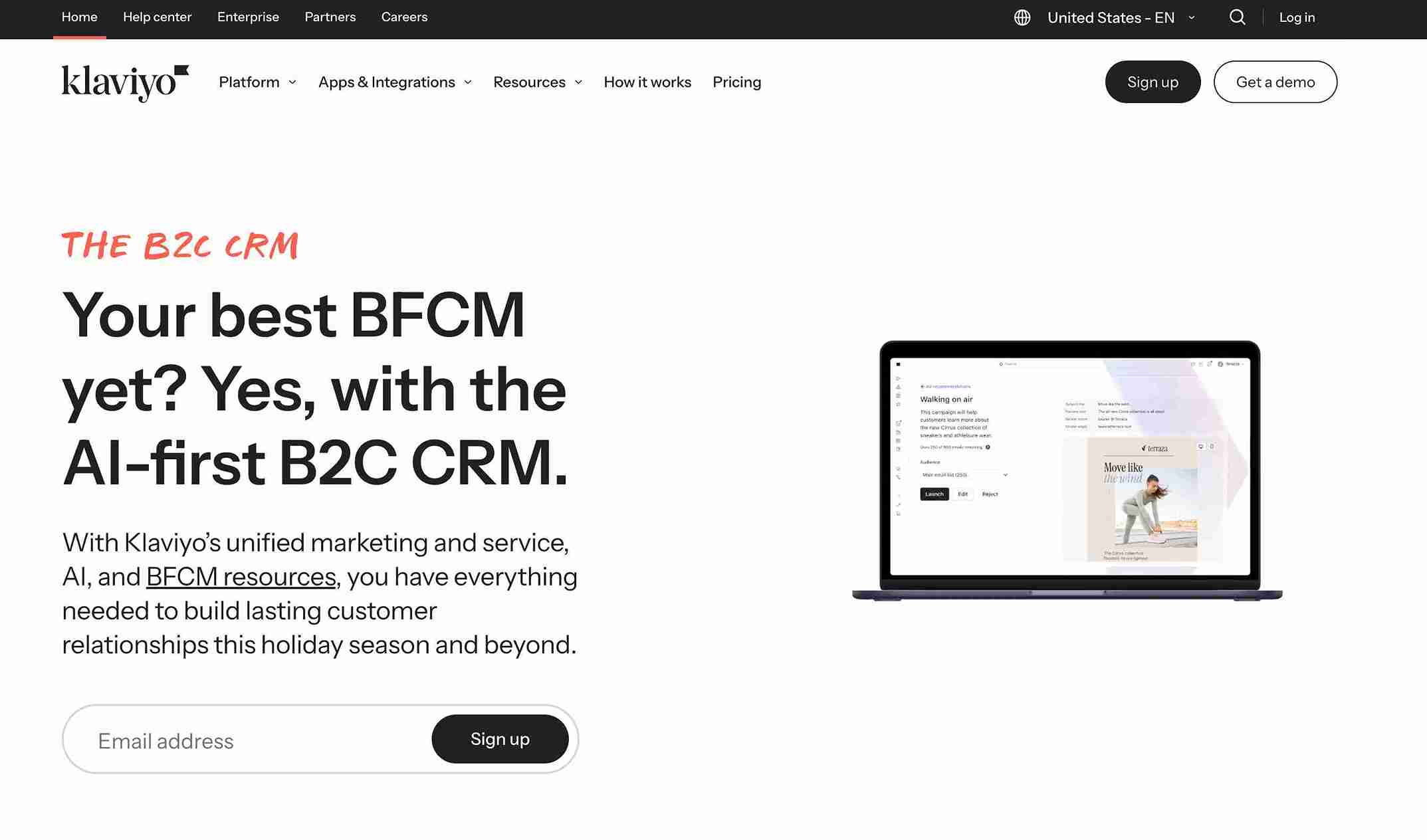
Klaviyo built its entire platform around e-commerce data. The platform’s predictive analytics set it apart (predicting customer lifetime value, churn risk, and next purchase dates using machine learning). It goes beyond merely tracking email opens — you’re forecasting revenue based on shopping behavior.
Key services or features offered by Klaviyo
Klaviyo provides data-driven e-commerce tools:
- Over 60 pre-built e-commerce workflows
- Predictive analytics forecasting lifetime value and churn risk
- Unified customer profiles with purchase history and browsing behavior
- One-click Shopify integration plus deep WooCommerce and Magento connections
- Dynamic product recommendations based on customer behavior
- Revenue-attributed reporting showing channel performance
Klaviyo pricing
Free plan covers 250 contacts and 500 monthly emails. Paid plans start at $20-45/month and scale with contact count. Pricing becomes expensive quickly (around $400/month for 25,000 contacts).
Pros and cons of Klaviyo
Weighing Klaviyo’s depth:
| Pros | Cons |
| Unmatched e-commerce data integration | Steep learning curve |
| Predictive analytics and insights | Pricing scales quickly |
| Revenue-focused reporting | Mainly suited for physical product sellers |
| Comprehensive Shopify integration | Limited support (chat and email only) |
What users say about Klaviyo
E-commerce businesses praise Klaviyo’s depth and revenue attribution. Complaints focus on complexity (many hire agencies to manage it). One Shopify owner told me Klaviyo transformed their email revenue, but required three months of learning.
6. Drip
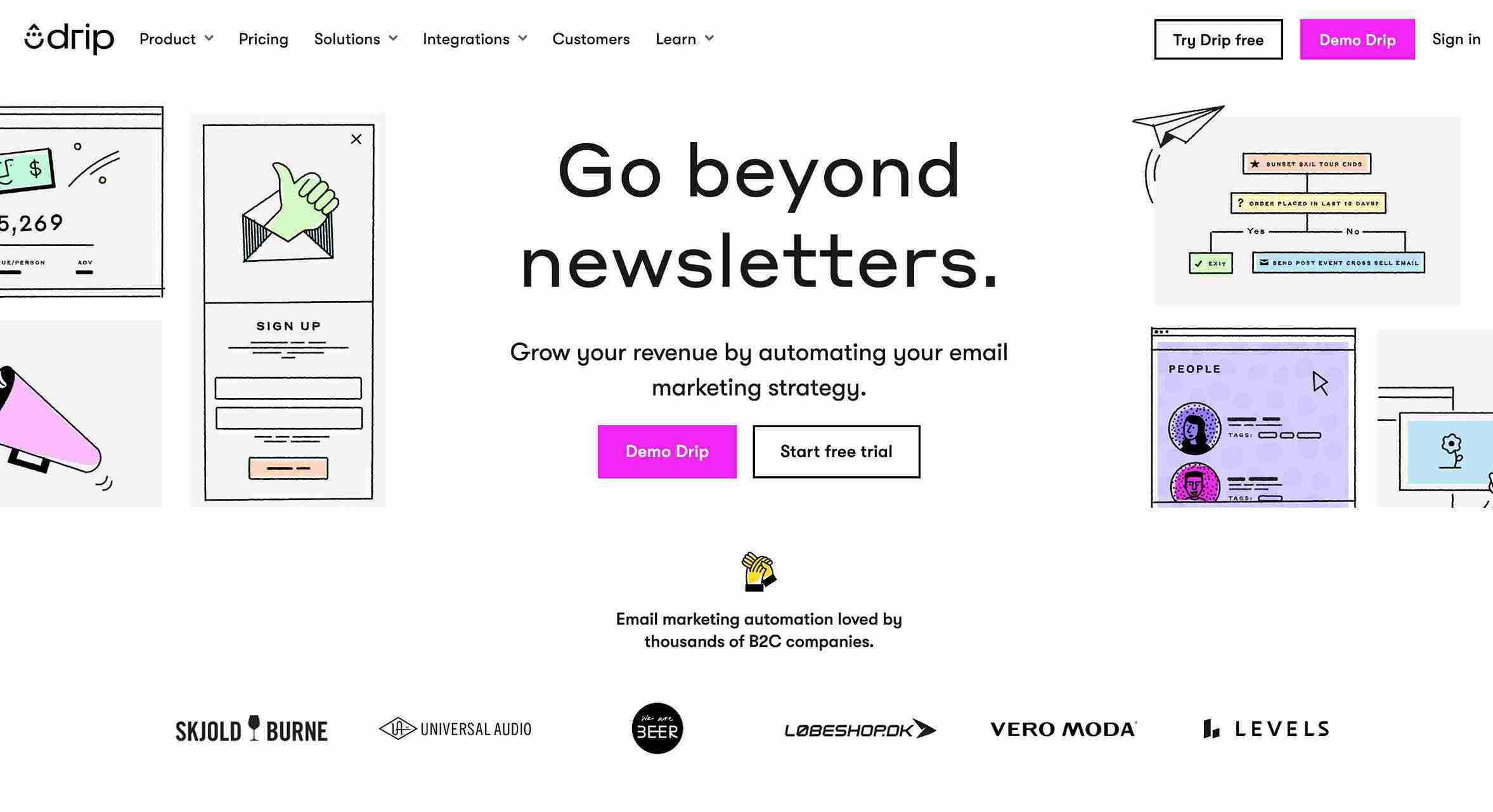
Drip exclusively serves DTC (direct-to-consumer) e-commerce brands. Every feature gets developed by asking, “Does this help DTC brands sell more products?” Audience lists update automatically based on real-time shopping actions (not days later like some platforms).
Key services or features offered by Drip
Drip specializes in DTC automation:
- Pre-built workflow templates
- Purchase-triggered automation workflows
- Revenue metrics for every email and automation
- Visual email builder with 50+ e-commerce templates
- Dynamic behavioral segments updating in real-time, on-site campaigns with pop-ups based on visitor behavior
Drip pricing
Starts at $39/month for up to 2,500 contacts, scaling as lists grow. One comprehensive paid plan includes all advanced features. No free plan exists, but a 14-day trial lets you test functionality.
Pros and cons of Drip
Understanding Drip’s specialization:
| Pros | Cons |
| Exclusively focused on DTC e-commerce | Expensive compared to general platforms |
| Superior onsite marketing | Not suitable for B2B or non-e-commerce |
| Revenue tracking on all campaigns | No free plan |
| Real-time behavioral segmentation | May require immediate store connection |
What users say about Drip
DTC brands appreciate Drip’s specialized focus and revenue reporting. Users feel confident that the platform understands their specific needs rather than treating e-commerce as an afterthought.
7. Omnisend
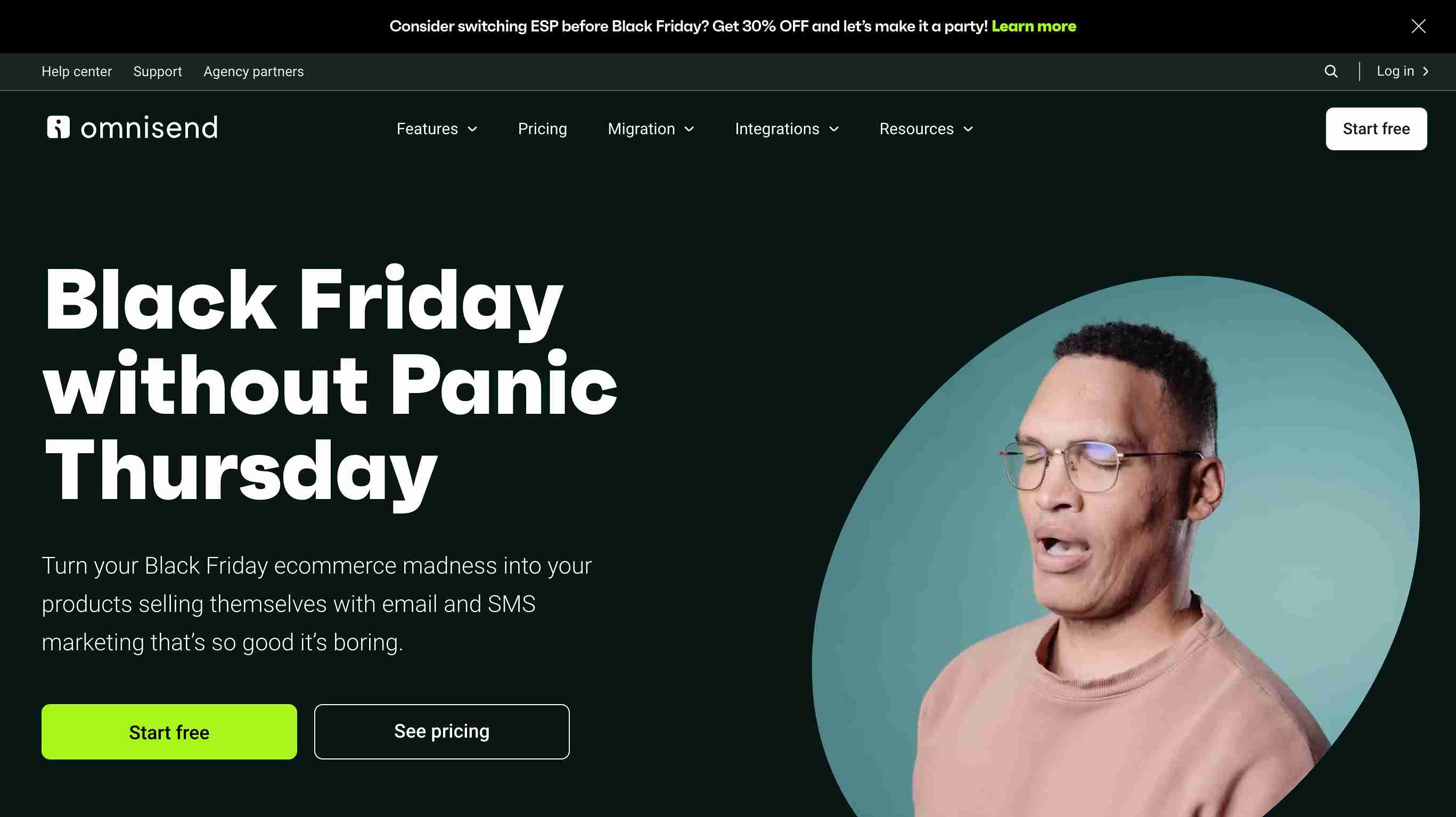
Omnisend specializes exclusively in e-commerce, serving over 100,000 Shopify, WooCommerce, and Wix stores. The platform’s omnichannel approach combines email, SMS, and web push notifications into unified workflows. You’re managing all communication channels from one dashboard (not juggling three separate tools).
Key services or features offered by Omnisend
Omnisend delivers integrated e-commerce tools:
- Revenue-attributed reporting by channel
- Omnichannel automation combining email, SMS, and web push
- Dynamic content with product recommendations based on shopping behavior
- Pre-built workflows for welcome series, cart abandonment, and product abandonment
- Gamified lead capture forms (spin-to-win, scratch cards, gift boxes)
- Deep integrations with Shopify, WooCommerce, BigCommerce
Omnisend pricing
Free plan covers 250 contacts and 500 emails/month. Paid plans start around $16/month with transparent pricing.
Pros and cons of Omnisend
Evaluating Omnisend’s focus:
| Pros | Cons |
| Built exclusively for e-commerce | Not suitable for B2B or lead generation |
| Omnichannel workflows | Some features are only available for Shopify |
| Excellent value and transparent pricing | Less useful without an online store |
| Strong engagement tools | Limited outside retail context |
What users say about Omnisend
Online retailers praise pre-built workflows and multichannel capabilities. Setting up abandoned cart sequences takes minutes instead of hours.
8. FunnelKit Automations
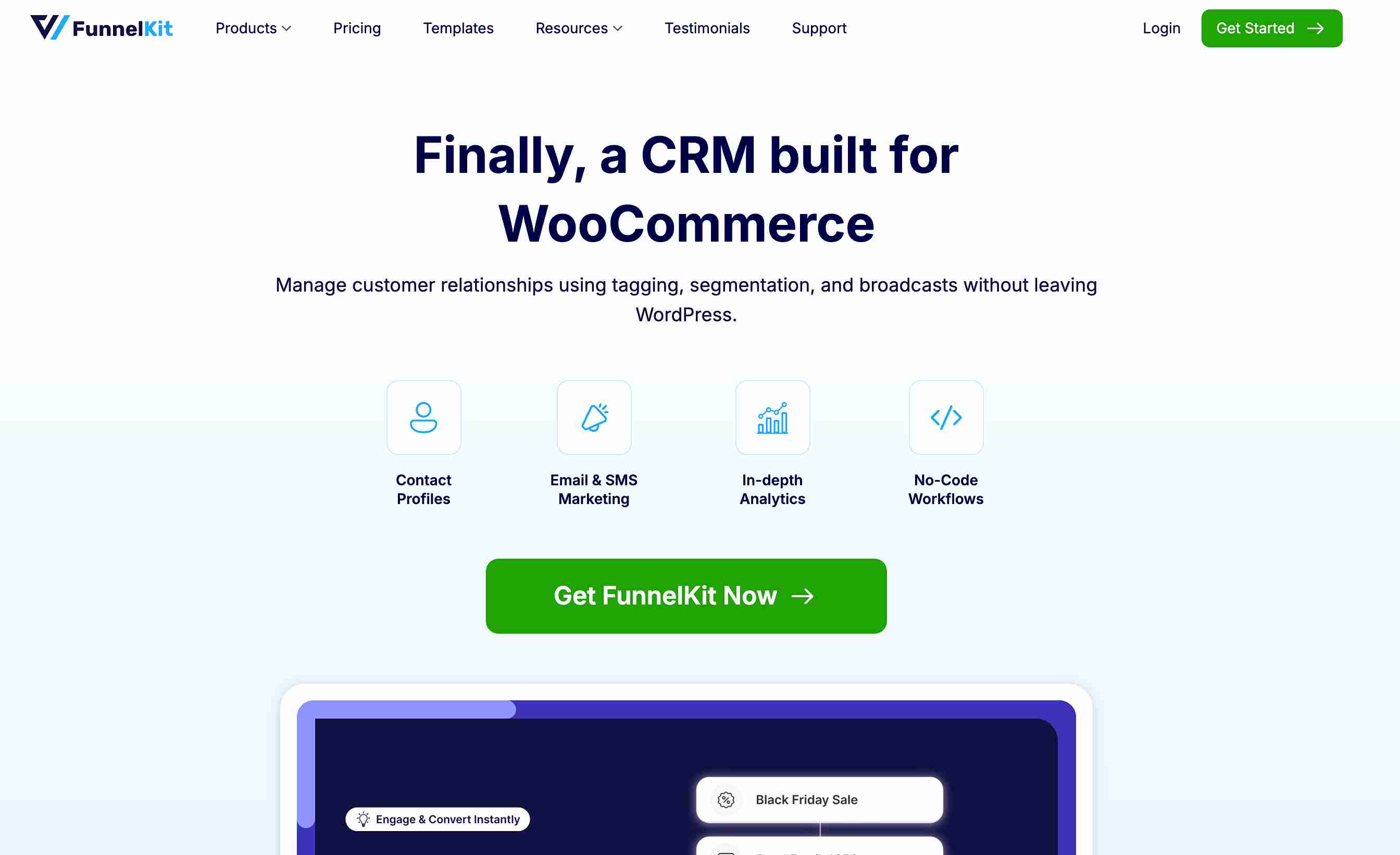
FunnelKit operates as a WordPress plugin designed specifically for WooCommerce stores. Unlike SaaS platforms that charge per contact, FunnelKit stores everything in your WordPress database alongside WooCommerce data. You capture more detailed purchase data (including upsells and downsells) because everything lives in one database.
Key services or features offered by FunnelKit Automations
FunnelKit provides WooCommerce-native automation:
- Purchase anniversary automations
- All WooCommerce transactional emails
- Shipment tracking integrations with status-based triggers
- Direct database integration, eliminating webhook dependencies
- Abandoned cart recovery and win-back campaigns
- Email and SMS marketing campaigns
FunnelKit Automations pricing
Fixed annual pricing at $249.50/year for unlimited contacts. Compared to Klaviyo ($400/month for 25,000 contacts), FunnelKit delivers significant savings. You’ll also need an SMTP provider for email delivery.
Pros and cons of FunnelKit Automations
Understanding FunnelKit’s limitations:
| Pros | Cons |
| Fixed price with unlimited contacts | Only works with WordPress/WooCommerce |
| Native WordPress integration | Requires a separate SMTP service |
| Captures detailed purchase data | Not suitable for non-WooCommerce businesses |
| Loads fast even with large databases | Plugin architecture limits some features |
What users say about FunnelKit Automations
WooCommerce store owners love the cost savings. One client replaced their $350/month Klaviyo subscription with FunnelKit and reported identical results.
9. Kit (ConvertKit)
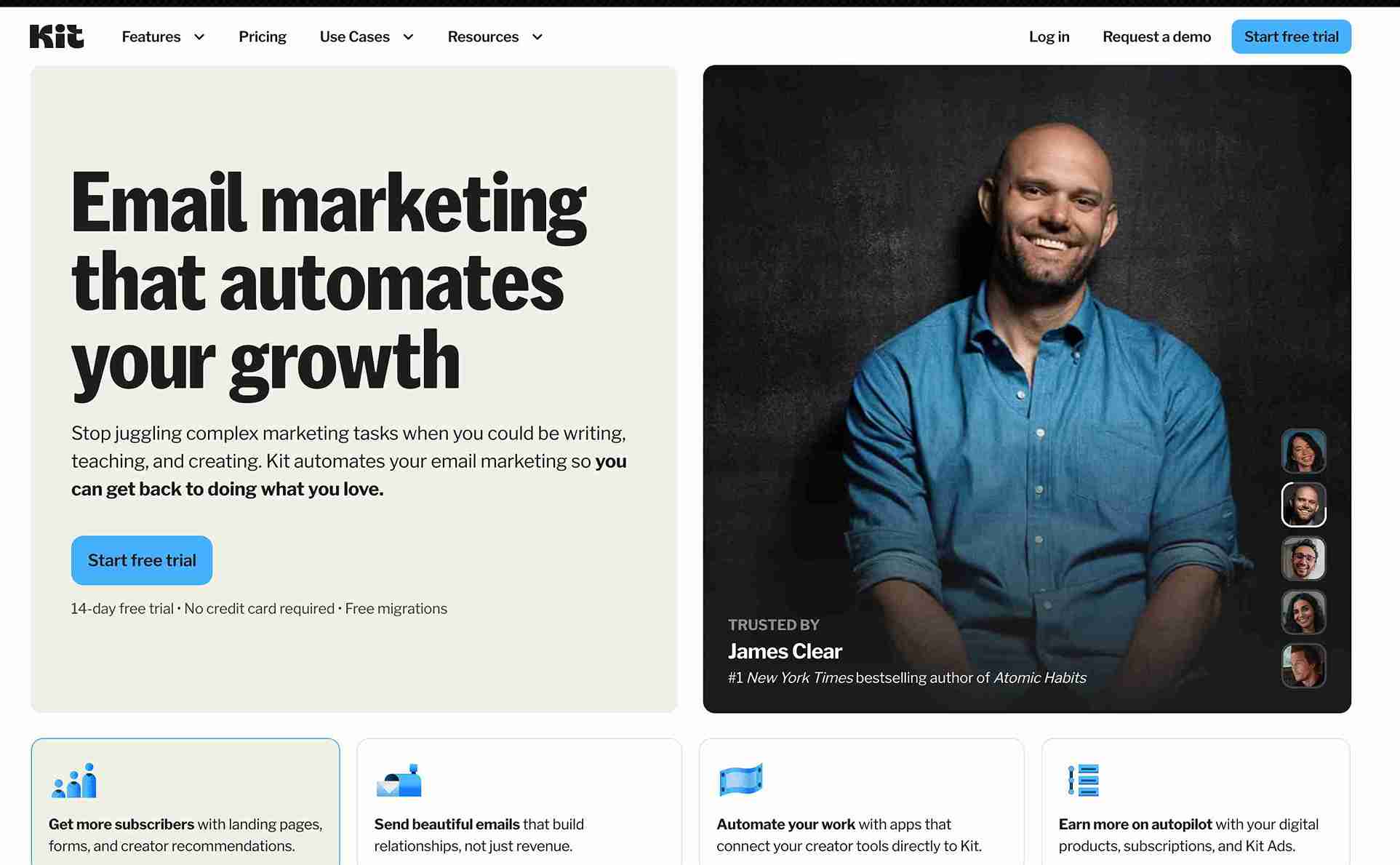
Kit built its platform exclusively for content creators, bloggers, and digital entrepreneurs who monetize audiences through digital products and subscriptions. The platform’s Creator Network enables cross-promotion with other newsletter publishers. You’re driving subscriber growth through recommendations (not just hoping people find you organically).
Key services or features offered by Kit
Kit delivers creator-focused monetization tools:
- Paid newsletter subscriptions (no revenue cut)
- Creator Network for cross-promotion and referrals
- Landing page builder and Linktree alternative for social bios
- Tag-based subscriber management, avoiding duplicate billing
- Visual automation builder for behavior-triggered sequences
- ConvertKit Commerce for selling digital products
Kit pricing
Free plan covers up to 1,000 subscribers with basic features. Creator plan starts at $9/ $9/month (annually) or $15-29/month, unlocking full automations. Creator Pro starts at $25-59/month with subscriber scoring, deliverability reporting, and priority support.
Pros and cons of Kit
Balancing simplicity and features:
| Pros | Cons |
| Native product selling and monetization | Gets expensive as the list grows |
| Strong deliverability rates | Reporting lacks depth and metrics |
| Creator Network drives growth | Limited A/B testing |
| Tag-based system prevents duplicate charges | Not suitable for complex B2B or SaaS |
What users say about Kit
Creators appreciate a simplified interface and built-in monetization (selling products without connecting to external services). Pricing becomes a concern once lists exceed 5,000 subscribers.
10. Beehiiv
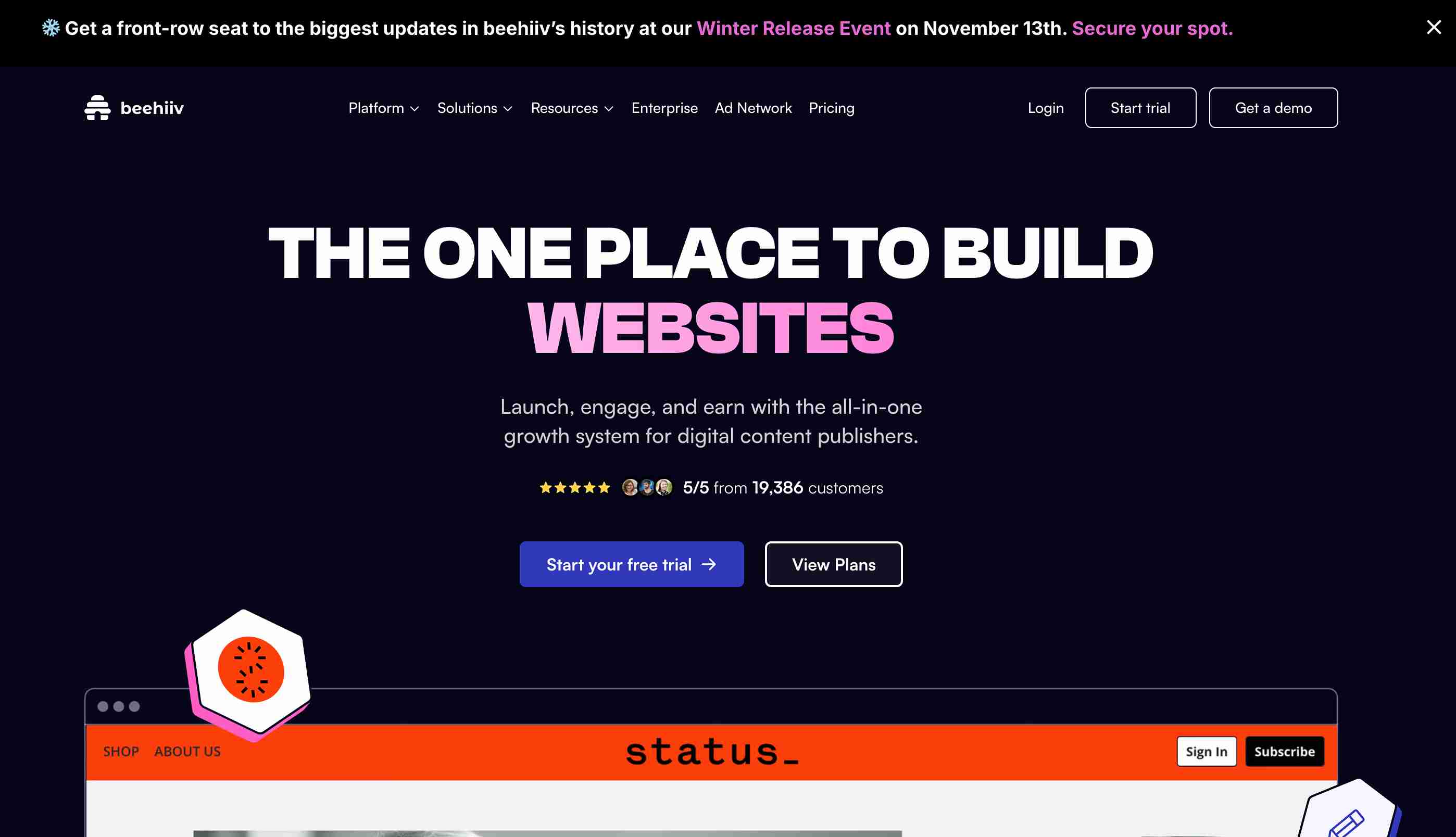
Beehiiv specializes in newsletter publishing with built-in growth and monetization tools. The platform doesn’t take a cut of paid newsletter revenue (unlike competitors like Substack). You keep all your earnings while using their growth infrastructure.
Key services or features offered by Beehiiv
Beehiiv provides newsletter-specific growth tools:
- Native ad network for monetization
- Cross-promotion with other Beehiiv creators
- Paid newsletter subscriptions (no revenue sharing)
- Intuitive email builder supporting text-based or designed emails
- Referral platform incentivizing subscriber sharing
- Migration tools from ActiveCampaign
Beehiiv pricing
Free plan covers up to 2,500 subscribers. The Max plan costs $96/month (billed annually), with custom Enterprise pricing available.
Pros and cons of Beehiiv
Understanding Beehiiv’s trade-offs:
| Pros | Cons |
| Affordable pricing regardless of list size | Very limited automation and segmentation |
| Native monetization without revenue sharing | No true CRM functionality |
| Network effects drive subscriber growth | Missing some advanced features |
| Simple, beginner-friendly interface | Can’t collect extensive data beyond email |
What users say about Beehiiv
Newsletter publishers love Beehiiv’s growth tools and affordable scaling. One creator told me they switched after their ActiveCampaign bill hit $600/month, dropping to $96/month with Beehiiv while maintaining identical open rates.
11. Flodesk
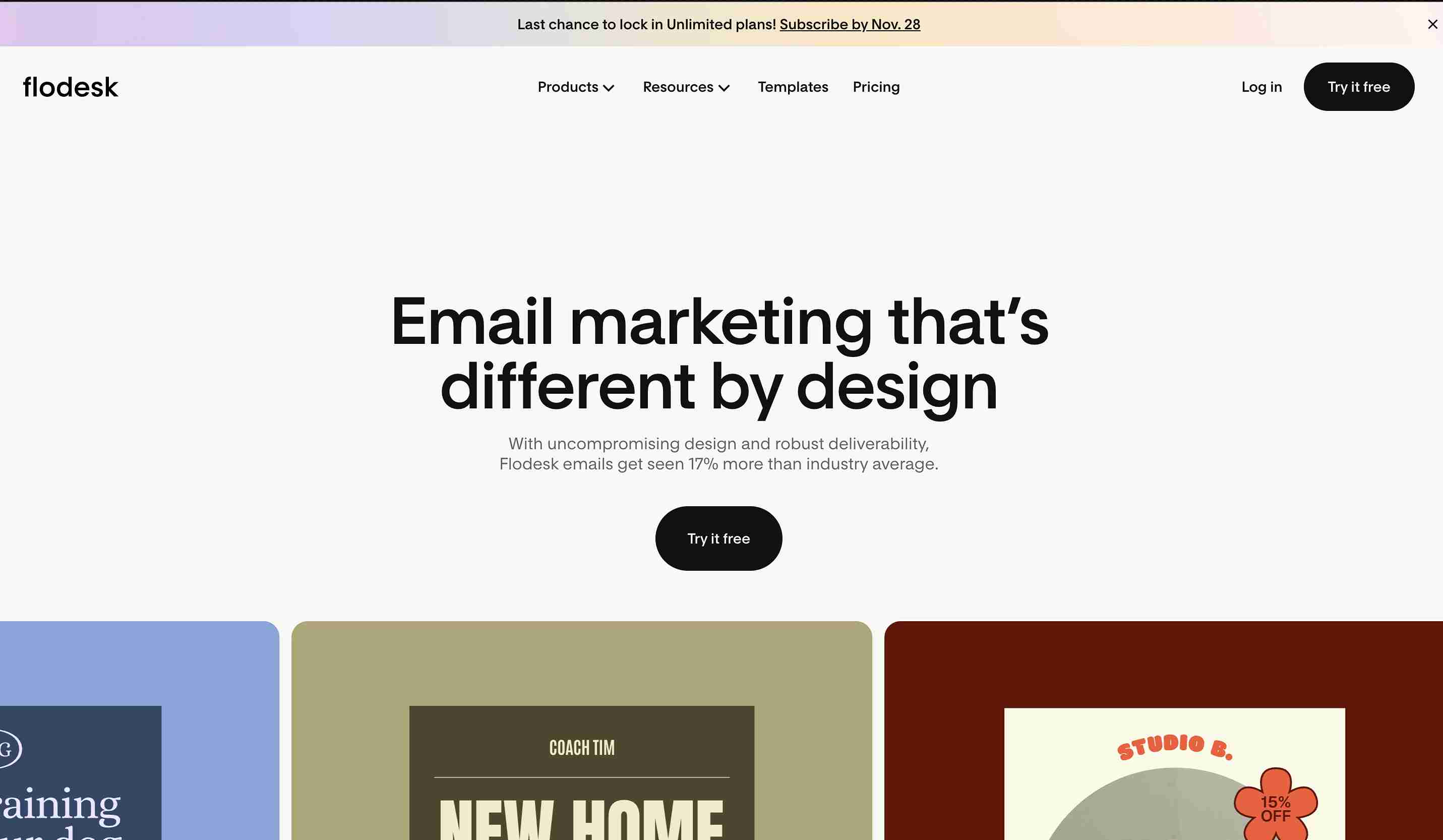
Flodesk targets design-conscious creators needing beautiful templates and flat-rate pricing that never increases with list growth. You’re not punished for growing your audience (the price stays at $35/month regardless of size). The platform specializes in creating visually stunning emails and forms without requiring design skills.
Key services or features offered by Flodesk
Flodesk provides design-focused email marketing:
- Four pre-built drip templates
- Drag-and-drop editor with brand customization
- Flat-rate pricing ($35/month) for unlimited subscribers
- Beautiful, feminine email templates with an extensive font library
- Unlimited full-page forms usable as landing pages
- Visual automation builder for simple workflows
Flodesk pricing
Fixed $35/month for unlimited subscribers and unlimited email sends. The company guarantees never raising prices as your list grows.
Pros and cons of Flodesk
Weighing design against complexity:
| Pros | Cons |
| Flat rate regardless of subscriber count | Automation is too simplistic for complex needs |
| Exceptionally beautiful templates | Basic analytics and reporting |
| Easy for beginners | Lacks advanced segmentation |
| No website required for forms | The missing goals feature in automation |
What users say about Flodesk
Creators praise Flodesk’s aesthetics and pricing model, particularly those with large lists. Complaints center on limited automation (fine for simple newsletters, inadequate for sophisticated sequences).
12. Brevo (Sendinblue)
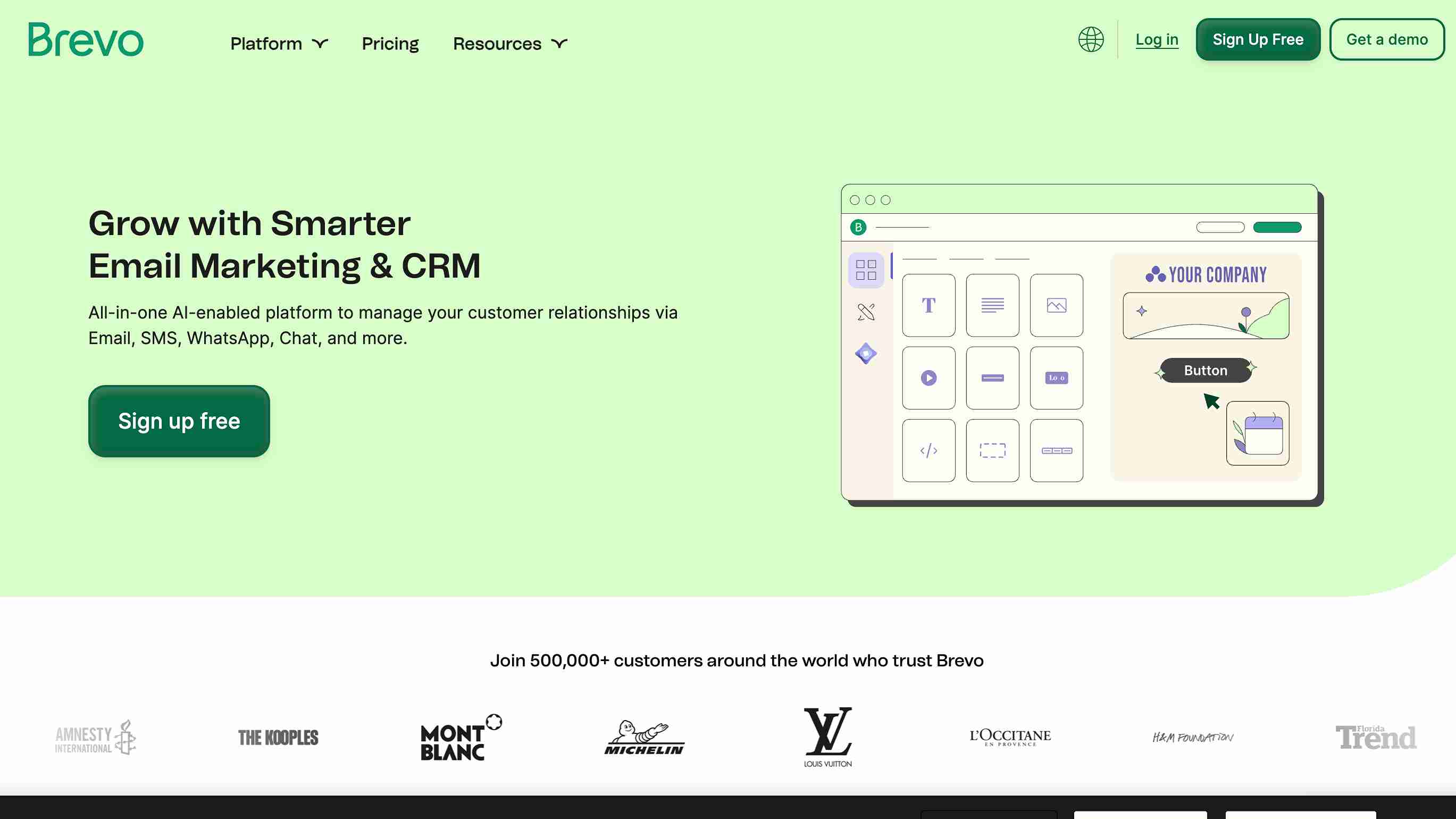
Brevo charges based on emails sent rather than contacts stored. You’re accumulating unlimited contacts without increasing costs (perfect for businesses with large lists but infrequent sending). The platform includes a free CRM and transactional email service on all plans (even free).
Key services or features offered by Brevo
Brevo delivers comprehensive tools at budget prices:
- Transactional email service included
- Email, SMS, and WhatsApp marketing
- Automated workflows at reasonable prices
- Unlimited contacts on all plans (pricing based on emails sent)
- User-friendly drag-and-drop email editor
- Free CRM is available across all tiers
Brevo pricing
Free forever plan covers unlimited contacts with 300 emails daily. Starter plan around $25/month, depending on email volume. Removing Brevo branding costs an additional $10-12/month.
Pros and cons of Brevo
Understanding Brevo’s value:
| Pros | Cons |
| Pay per email sent, not contacts | Daily sending limit on the free plan |
| Free CRM on all plans | Advanced features are locked behind the Business tier |
| Includes transactional emails | Branding removal costs extra |
| Very affordable for large lists | Less depth than enterprise platforms |
What users say about Brevo
Users appreciate Brevo’s pricing flexibility and built-in CRM. The automation receives praise for being more intuitive than ActiveCampaign’s. Complaints focus on the limited free tier (300 daily emails).
13. MailerLite
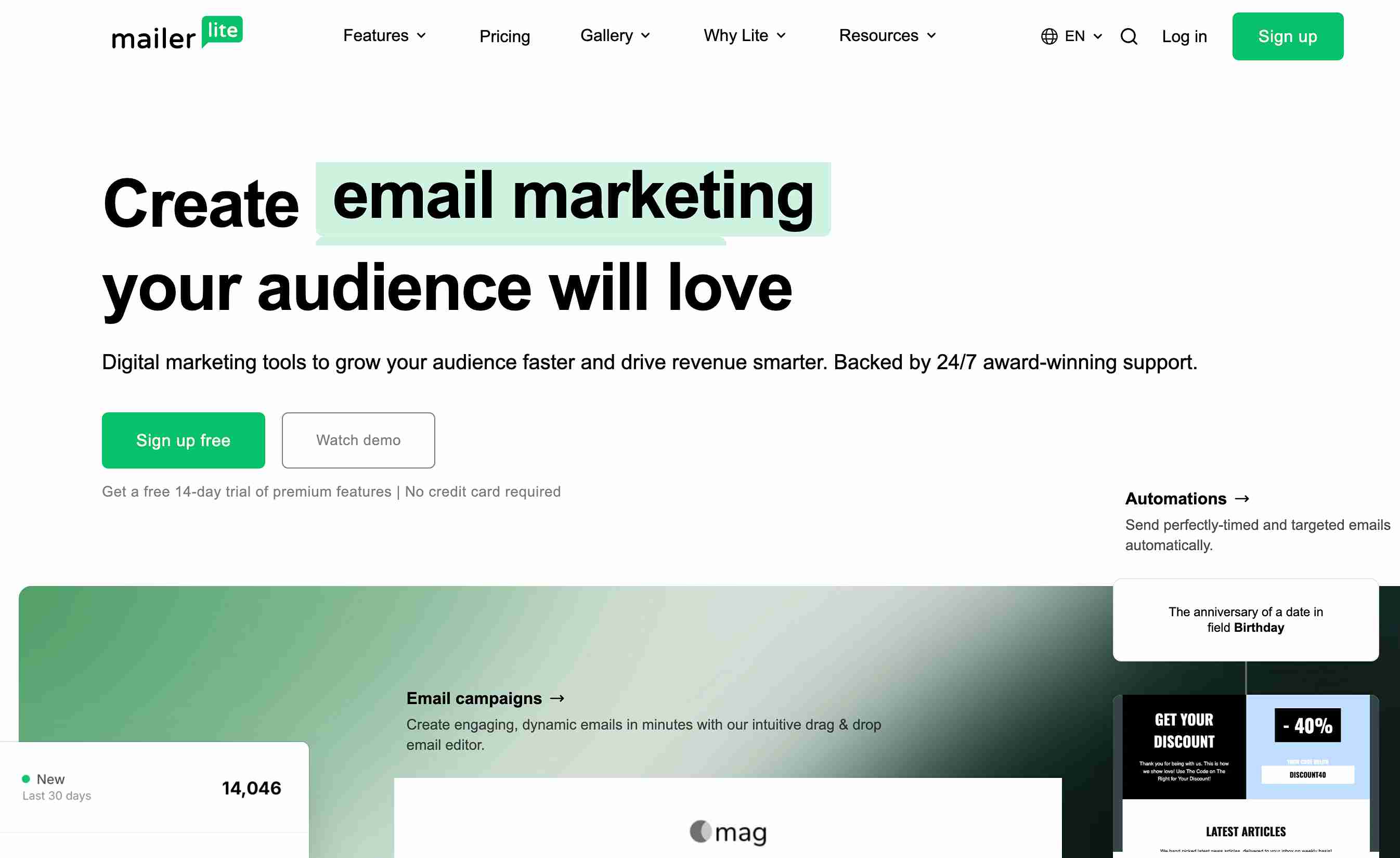
MailerLite specializes in beginner-friendly simplicity with one of the most generous free plans available. The platform prioritizes intuitive design over feature complexity (perfect for first-time email marketers). You’re launching campaigns within hours instead of weeks spent learning ActiveCampaign’s interface.
Key services or features offered by MailerLite
MailerLite provides essentials without complexity:
- Simple drag-and-drop email editor
- Robust free plan with landing pages and automation
- Landing page creator with custom domain support (paid plans)
- E-commerce integration (Shopify, WooCommerce) with Stripe support
- Visual automation builder with single and multi-trigger options
- A/B testing, segmentation, and real-time analytics
MailerLite pricing
Free forever plan covers 1,000 subscribers with 12,000 monthly emails. Growing Business plan starts at $10/month for 1,000 subscribers with unlimited emails.
Pros and cons of MailerLite
Evaluating MailerLite’s simplicity:
| Pros | Cons |
| Extremely affordable and transparent | Basic automation compared to advanced platforms |
| Very simple for beginners | Limited advanced features |
| Generous free plan with real functionality | May outgrow it as needs become complex |
| Clean, uncluttered interface | Smaller integration ecosystem |
What users say about MailerLite
Beginners love MailerLite’s simplicity and generous free tier. Long-term users mention that the platform works perfectly for straightforward email marketing, but eventually requires upgrading as needs become complex.
14. Mailchimp
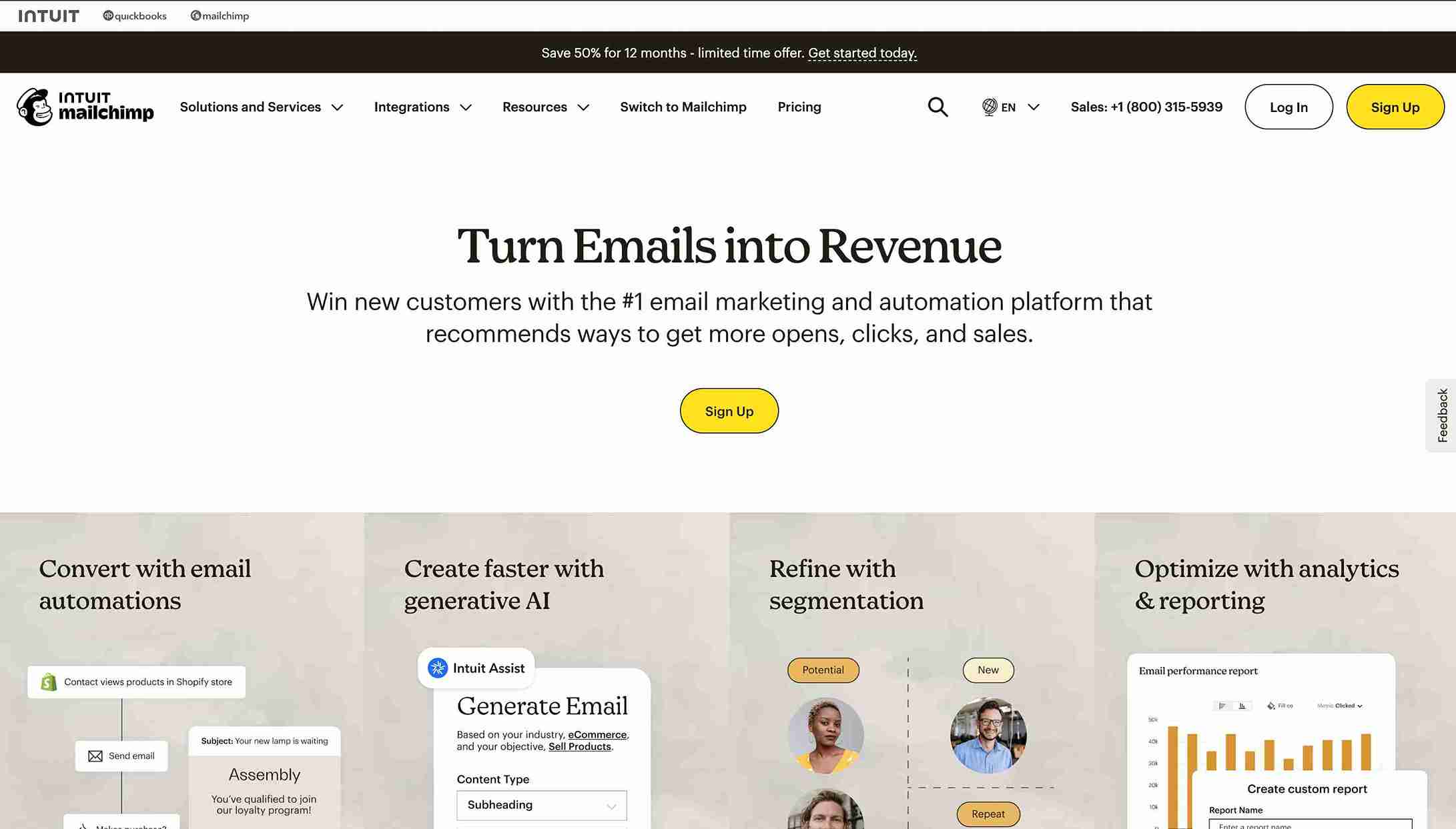
Mailchimp popularized email marketing through beginner-friendly design and a free plan serving millions of small businesses. The platform focuses on shallow learning curves and massive integration options (5,000+ integrations) rather than advanced automation depth. You’re choosing familiarity and reliability over cutting-edge automation features.
Key services or features offered by Mailchimp
Mailchimp provides accessible email marketing essentials:
- Over 5,000 integrations
- Pop-up forms and social posting
- Built-in CRM and basic segmentation
- Forever free plan (500 contacts, 1,000 monthly sends)
- Intuitive drag-and-drop email editor
- Pre-built automation journeys
Mailchimp pricing
Free forever plan covers 500 contacts with 1,000 monthly emails. Essentials plan starts at $13/month (annually) for 500 contacts or $26.50/month for 1,000 contacts. Costs rise quickly (reaching $270/month for 25,000 contacts on Essentials).
Pros and cons of Mailchimp
Understanding Mailchimp’s limitations:
| Pros | Cons |
| Massive brand recognition and reliability | Charges for inactive/unsubscribed contacts |
| Shallow learning curve for beginners | Pricing escalates quickly with growth |
| Extensive integration marketplace | Automation is less robust than its competitors |
| Generous free tier | Charges twice for duplicate contacts across lists |
What users say about Mailchimp
Beginners appreciate Mailchimp’s familiarity and ease of setup. Complaints emerge during scaling when users discover they’re paying for unsubscribed contacts and duplicates. Many migrate away once lists exceed 5,000 contacts.
15. GMass
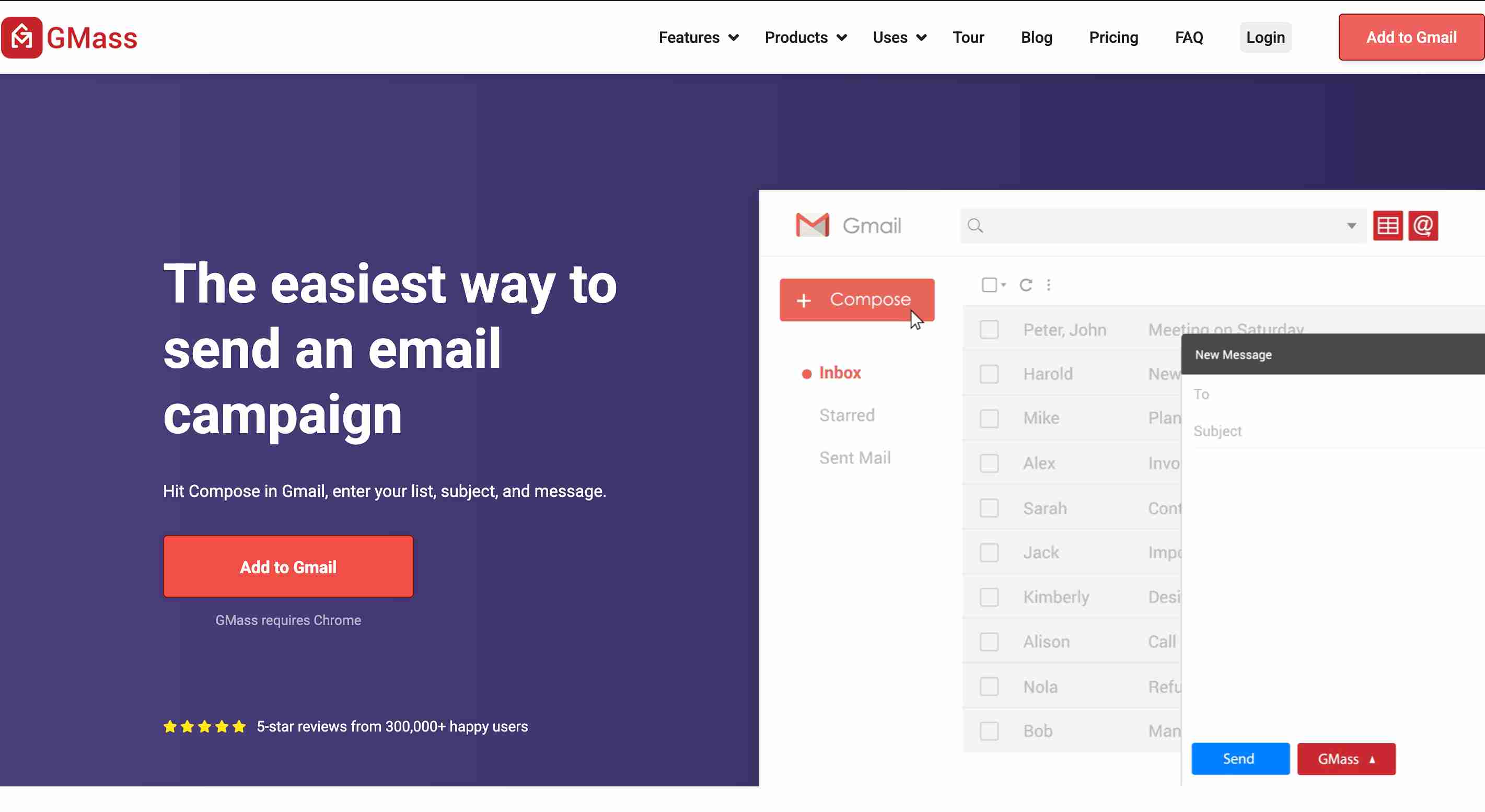
GMass operates entirely inside Gmail as a Chrome extension. You’re not learning a new dashboard (campaigns send directly from Gmail using your existing workflow). The platform transforms your familiar email interface into a powerful marketing tool without disrupting your daily routine.
Key services or features offered by GMass
GMass provides Gmail-native marketing automation:
- Google Sheets integration for mail merges
- Email List Builder creating lists from Gmail search keywords
- Mass email personalization (names, images, links, paragraphs)
- Deliverability tools (Spam Solver, Email Verifier, Email Tester, SMTP Tester)
- Automated follow-up sequences with customizable triggers
- Works entirely inside Gmail (Chrome extension)
GMass pricing
Pricing varies based on features selected, with different tiers depending on sending volume and capabilities. Generally considered cost-effective for Gmail users needing advanced features without complex platforms.
Pros and cons of GMass
Evaluating Gmail-native approach:
| Pros | Cons |
| Works within the familiar Gmail interface | Requires a Gmail or Google Workspace account |
| No new platform to learn | Desktop version requires Chrome |
| Cost-effective for Gmail users | Limited to the Google ecosystem |
| Comprehensive deliverability tools | Not suitable for teams needing broader CRM |
What users say about GMass
Gmail power users love GMass’s simplicity and integration. One consultant told me GMass works perfectly for her solopreneur business, but wouldn’t scale for her agency’s client work requiring team collaboration.
16. Constant Contact
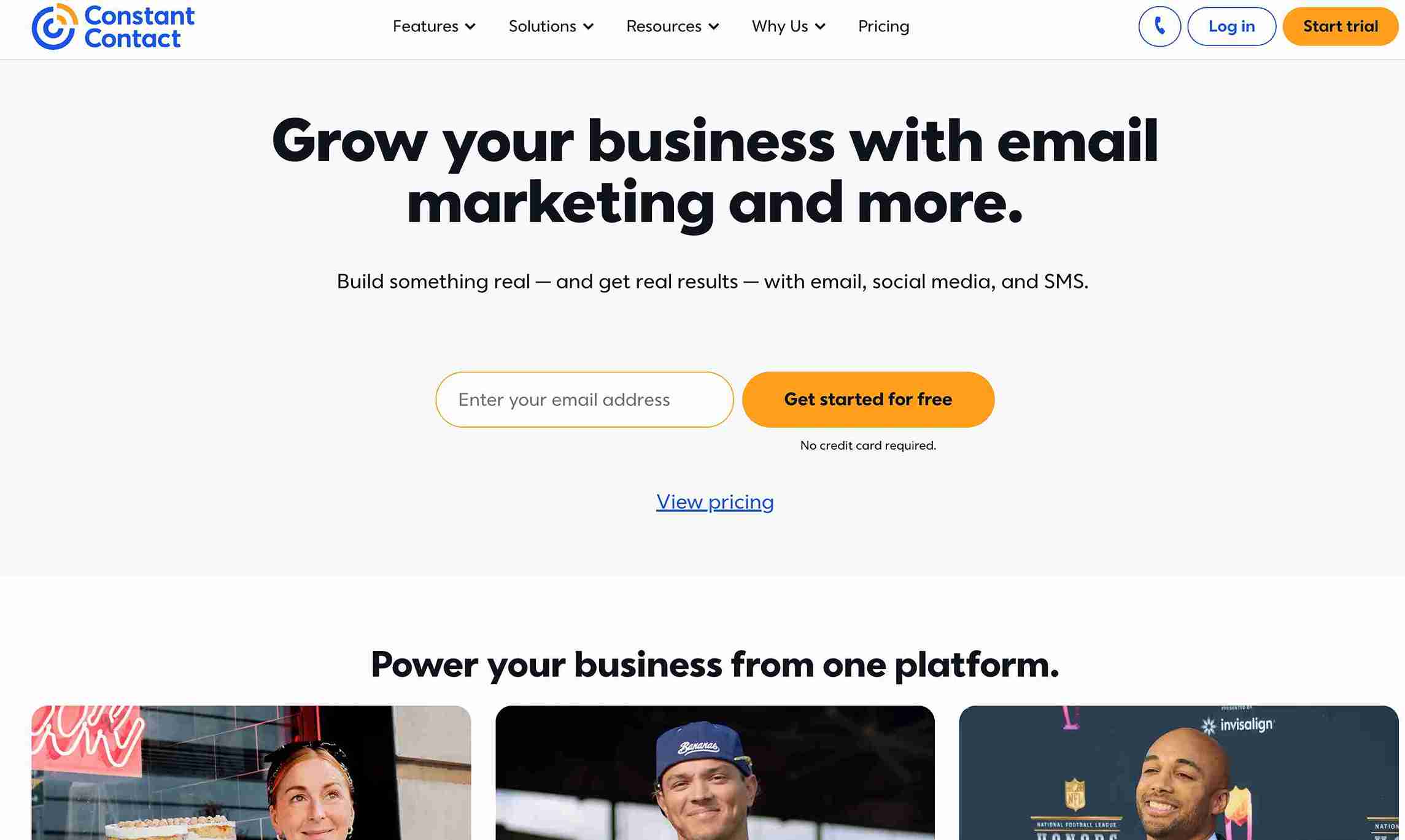
Constant Contact specializes in event management and small business simplicity, serving solopreneurs and SMBs since 1995. The platform prioritizes reliable delivery and straightforward tools perfect for beginners. Event organizers particularly love the native ticketing integration (no juggling separate tools for registration and email campaigns).
Key services or features offered by Constant Contact
Constant Contact delivers reliable core functionality:
- Extensive integrations
- Built-in CRM and pipeline management
- Over 200 professionally designed email templates
- Native event management (tickets, registrations, RSVPs)
- Social media ad creation and post scheduling
- High deliverability rates
Constant Contact pricing
Starts at $12/month for up to 500 contacts with a notably long 60-day free trial. Pricing scales with contacts but offers 30% nonprofit discounts.
Pros and cons of Constant Contact
Balancing simplicity and sophistication:
| Pros | Cons |
| Excellent deliverability rates | Basic automation compared to ActiveCampaign |
| Unique event management features | Pricing scales for large lists |
| Very beginner-friendly interface | Segmentation not intuitive |
| Long 60-day free trial | Advanced features on higher tiers only |
What users say about Constant Contact
Users praise Constant Contact’s reliability and event tools. Event organizers specifically mention that the native ticketing integration saves them from juggling separate tools.
17. HighLevel
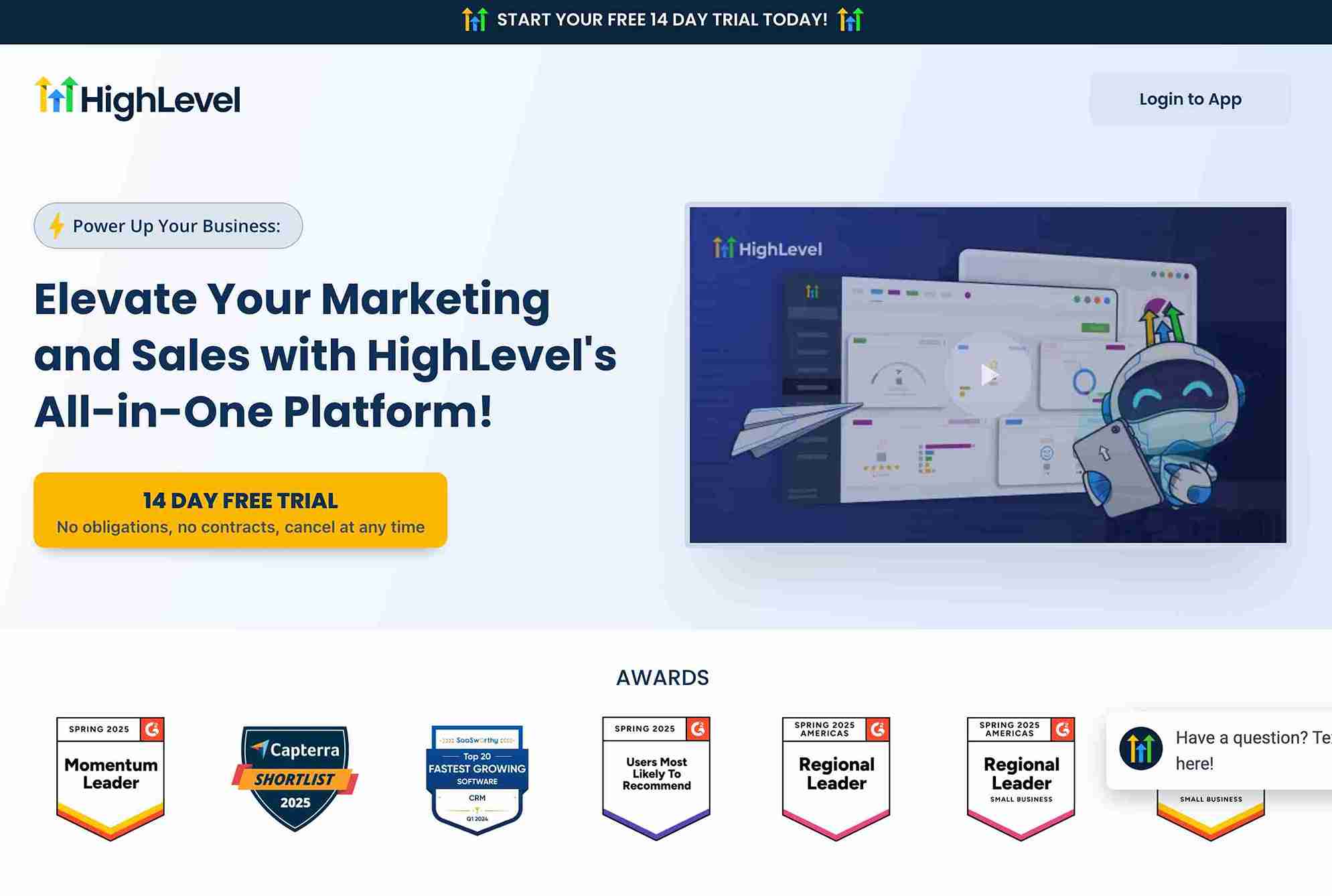
HighLevel serves marketing agencies exclusively, offering white-label reselling capabilities that create recurring SaaS revenue streams. Built by agency owners for agency owners, HighLevel asks “Will this help agencies?” before adding any feature. You’re replacing the common practice of “duct-taping different platforms together” (one user reported replacing over $800 worth of software by consolidating into HighLevel).
Key services or features offered by HighLevel
HighLevel provides agency-specific tools:
- White-labeled mobile app
- Call tracking and reputation management
- White-labeling allows resale as your own software
- All-in-one marketing engine (landing pages, emails, websites)
- Native tools reducing Zapier dependency
- Unlimited contacts at a fixed price
HighLevel pricing
Agency unlimited plan at $297/month with unlimited contacts. Compared to ActiveCampaign’s escalating per-contact pricing, HighLevel delivers predictable costs for agencies managing multiple client accounts. The white-label reselling creates additional revenue streams.
Pros and cons of HighLevel
Understanding agency-specific value:
| Pros | Cons |
| White-label reselling creates SaaS revenue | Built specifically for agencies only |
| Unlimited contacts at a fixed price | Higher entry price than basic tools |
| Consolidates multiple agency tools | Learning curve for full platform mastery |
| Native call tracking and reputation tools | Overkill for non-agency businesses |
What users say about HighLevel
Agency owners rave about white-label capabilities and cost savings from consolidation. Users mention the platform reduces complexity once implemented, though initial setup requires investment.
Keep your emails out of spam with your new platform
Switching platforms solves your ActiveCampaign problems, but migration often tanks your inbox rate overnight. New domains, different sending patterns, and ESP suspicion combine to land your carefully crafted campaigns in spam.
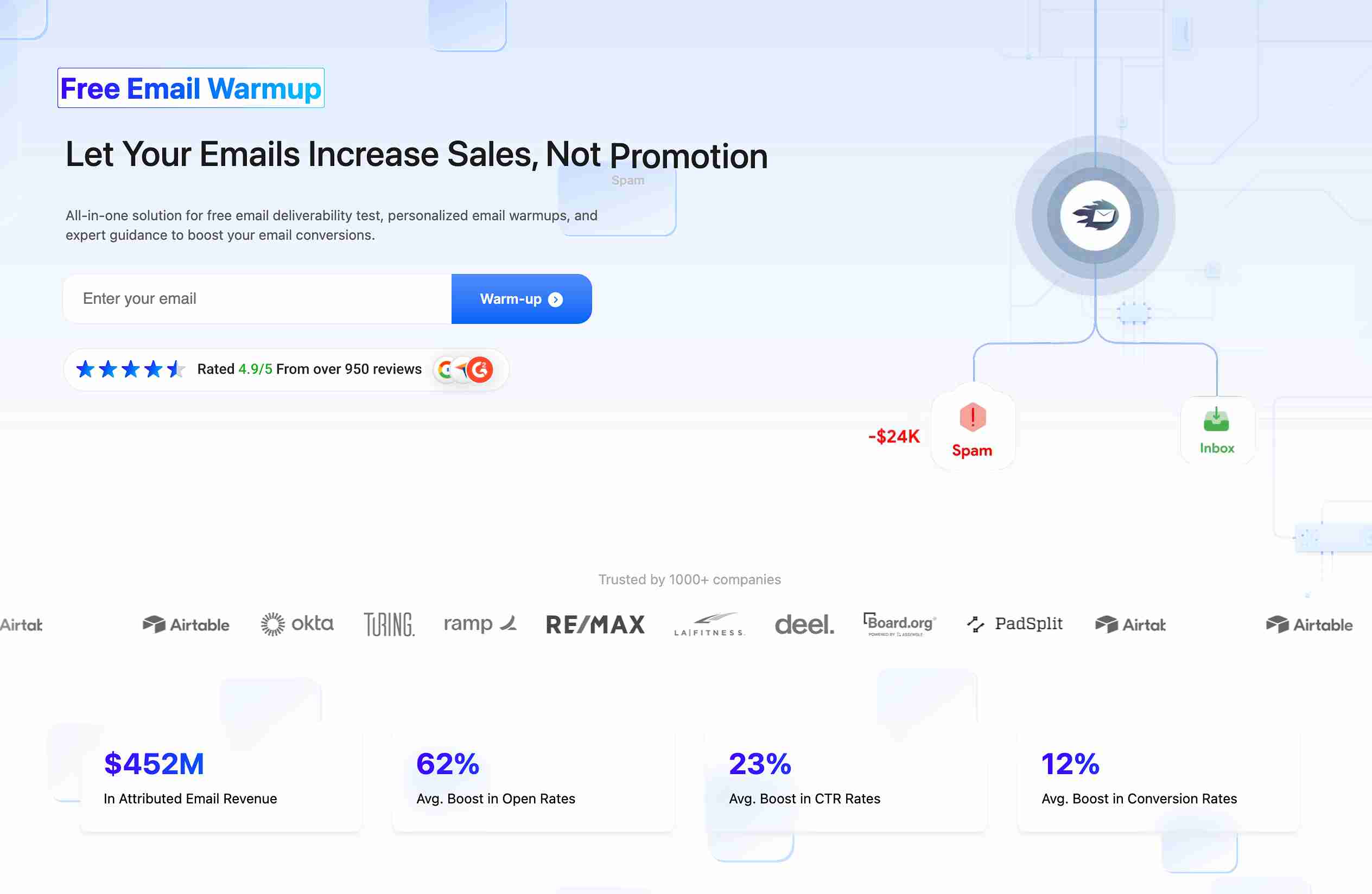
EmailWarmup.com ensures your new platform actually reaches inboxes:
- Free deliverability testing without limits
- Smart email spam checker showing real-time inbox rates
- Personalized automated email warmup matching your sending style
- Unlimited consultations with an email deliverability consultant
Start your free warmup with us.
How to choose the right alternative
Your perfect ActiveCampaign replacement depends on matching platform strengths to your specific workflow:
- Agencies need white-labeling (HighLevel)
- Sales teams need robust CRMs (HubSpot, Close)
- Online stores require e-commerce specialists (Klaviyo, Omnisend)
- Rapid list growth demands capped pricing (Brevo, Flodesk, FunnelKit)
- Beginners should prioritize simplicity (MailerLite, Mailchimp)
- Creators need monetization tools (Kit, Beehiiv)
Frequently asked questions about ActiveCampaign alternatives
Here are commonly asked questions about ActiveCampaign alternatives:
EngageBay offers comprehensive automation, CRM, and marketing features starting at $11.04/month. MailerLite provides simpler automation at $10/month for 1,000 subscribers. Both include free plans for testing.
Most platforms offer CSV import tools for contacts and basic data. Advanced migrations (automations, tags, custom fields) require tools like Import2 or manual rebuilding. Plan for 2-4 weeks of migration time for complex setups.
Deliverability depends more on sender reputation and list hygiene than on platform choice. Use EmailWarmup.com alongside any platform to maintain optimal inbox rates.
HubSpot provides enterprise-level CRM functionality with advanced pipeline management and reporting. Close specializes exclusively in sales CRM with unified communication. EngageBay offers solid CRM at budget prices. All three significantly outperform ActiveCampaign’s basic CRM capabilities.
Klaviyo dominates Shopify integrations with one-click setup, predictive analytics, and revenue attribution. Omnisend provides excellent value with omnichannel workflows. Both are purpose-built for e-commerce and offer dramatically better Shopify functionality than ActiveCampaign’s generic approach.
Beehiiv specializes in newsletter publishing with growth tools (referrals, cross-promotion) and monetization (ads, paid subscriptions). Kit works well for creators needing simple automation alongside newsletters. Both outperform ActiveCampaign for pure newsletter publishing.


